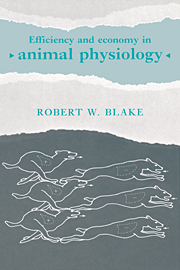Book contents
- Frontmatter
- Contents
- List of contributors
- Preface
- 1 Efficiency, effectiveness, perfection, optimization: their use in understanding vertebrate evolution
- 2 On the efficiency of energy transformations in cells and animals
- 3 Adapting skeletal muscle to be efficient
- 4 Efficiency and other criteria for evaluating the quality of structural biomaterials
- 5 Efficiency and optimization in the design of skeletal support systems
- 6 Efficiency in aquatic locomotion: limitations from single cells to animals
- 7 The concepts of efficiency and economy in land locomotion
- 8 Respiration in air breathing vertebrates: optimization and efficiency in design and function
- 9 Cardiac energetics and the design of vertebrate arterial systems
- 10 An evolutionary perspective on the concept of efficiency: how does function evolve?
- Index
1 - Efficiency, effectiveness, perfection, optimization: their use in understanding vertebrate evolution
Published online by Cambridge University Press: 03 October 2009
- Frontmatter
- Contents
- List of contributors
- Preface
- 1 Efficiency, effectiveness, perfection, optimization: their use in understanding vertebrate evolution
- 2 On the efficiency of energy transformations in cells and animals
- 3 Adapting skeletal muscle to be efficient
- 4 Efficiency and other criteria for evaluating the quality of structural biomaterials
- 5 Efficiency and optimization in the design of skeletal support systems
- 6 Efficiency in aquatic locomotion: limitations from single cells to animals
- 7 The concepts of efficiency and economy in land locomotion
- 8 Respiration in air breathing vertebrates: optimization and efficiency in design and function
- 9 Cardiac energetics and the design of vertebrate arterial systems
- 10 An evolutionary perspective on the concept of efficiency: how does function evolve?
- Index
Summary
HISTORY
Since before Aristotle, naturalists have noted that organisms are more or less matched to the environments they occupy. They also noted imperfections in that some organisms, individuals and species appeared obviously mismatched to the environment they then occupied.
Around the end of the eighteenth and start of the nineteenth centuries, these observations led to the wide array of hypotheses in Idealistic Morphology. Underlying many of these views was the idea that tissues and organisms were trying to express an innate pattern, in some schools referred to as the archetype. It was assumed by some students that the perceived world actually represented but a variable expression of this innate plan. Some species represented a closer fit to the underlying pattern and with this gave a better indication of the nature of this archetype. Hence, a major task of comparative biology was the deduction of the true archetype from the diversity of surviving species.
The theory of natural selection and its corollaries has provided a more appropriate explanation both for the kinds of environmental matching … and for the seeming degrees of mismatching to the environment. Still, for various reasons, some biologists and philosophers even today keep searching for alternate explanations for this matching and mismatching. Alternative hypotheses (with which I do not agree) for the existence of mismatching are, for instance, the Spandrels of Saint Mark hypothesis, according to which adaptation (curiously defined) does not derive from natural selection. Another is the concept of evolution by punctuated events in which an array of individuals or species exemplifying different phenotypic states arises and only those lines that encounter an environmental site matching their particular condition will survive.
- Type
- Chapter
- Information
- Efficiency and Economy in Animal Physiology , pp. 1 - 12Publisher: Cambridge University PressPrint publication year: 1992
- 1
- Cited by



